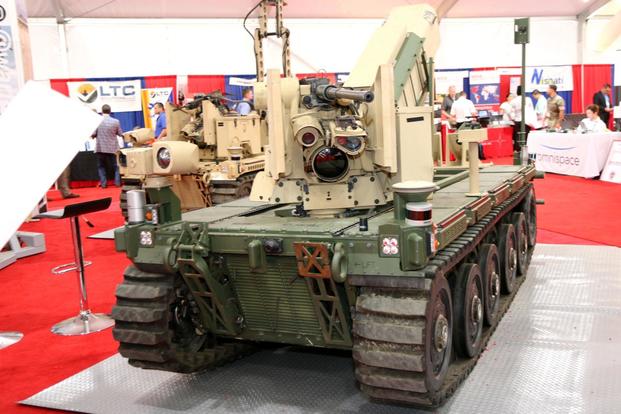QUANTICO, Virginia -- The Marine Corps is experimenting with new options for its unmanned, squad prototype vehicle, including rocket launchers and a remote weapon station armed with a .50-caliber machine gun.
The Marine Corps Warfighting Lab recently sent its Expeditionary Modular Autonomous Vehicle, or EMAV, to the Muscatatuck Urban Training Center in Indiana for a company of Marines to test in the dense urban terrain environment.
Marines tested one of the vehicles, equipped with a .50 cal. mounted on a Common Remotely Operated Weapon Station, or CROWS, to see how squads can benefit from having a heavy machine gun in their arsenal, Dave Stone, ground combat element robotics engineer for the Lab, told Military.com at the Modern Day Marine 2019 expo.
"The key idea is we are exploring how can we enhance the Marine's ability to execute his mission and give him some standoff ... and bring tools to the battle that he normally wouldn't be able to bring," he said. "This is bringing it down to the small-unit level, down to the squad level."
Related: Marine Corps Shelves Futuristic Robo-Mule Due to Noise Concerns
The autonomous vehicle has also been equipped with a "pusher bar" on the front for moving heavy obstacles.
"We are looking at, can that aid the Marines in clearing debris in and urban situation -- bombed-out cars?" Stone said. "Can they move them out of their way?"
The Warfighting Lab also just finished outfitting the vehicle with the Lethal Miniature Aerial Missile System, or LMAMS, a four-round launcher the can deliver loitering munitions, also known as “kamikaze drones” that "would bring precision fires to a lower [unit] level," he said.
LMAMS could be tested in fiscal 2020.
The Army is planning on fielding a smaller unmanned squad vehicle to combat units next year. The Small Multipurpose Equipment Transport, or SMET, is capable of hauling 1,000 pounds of ammunition, water and soldier gear for 60 miles within 72 hours.
The Marine Corps received its first EMAV prototype in early 2018, but it's not certain that it will be fielded in its current form. It can haul 7,000 pounds of payload and navigate by GPS waypoints, Stone said.
"It has follow-me mode, and it also has a waypoint navigation system," he added. "It will detect obstacles and avoid them, so if somebody walks in the path of it, it will slow down and go around."
The vehicle has a 16-gallon fuel tank and a range of about 50 miles. It can travel about 10 miles per hour in semi-autonomous mode and up to 28 miles per hour in remote-control mode, Stone said.
"These vehicles, as they sit, probably won't be what is fielded; we are informing requirements," he said. "We will probably put a couple of them into an end-user assessment at some point.
"That is what we do -- we take prototypes and we explore concepts with them," Stone said. "How do the Marines use them? What is the value?"
-- Matthew Cox can be reached at matthew.cox@military.com.
Read more: See Military.com's complete coverage of Modern Day Marine 2019













